 Enclosure:
Enclosure:
– Minimum size of enclosure should be 20 gallon (long) or equivalent (30” x 12” footprint).
– Enclosure should be constructed with solid walls (no screen cages), have adequate top or side ventilation, and have three sides darkened or covered.
– Enclosure should be secure with either latching doors or a screen held on with clips/locking mechanism.
Temperature:
– Primary basking heat should be provided with an under tank heater.
– Additional overheat heat in the form of a ceramic heat emitter or a blue heat bulb may be necessary if ambient air temperatures in the home are too low.
– The chosen heat source must be hooked up to a reliable thermostat, preferably a digital one.
– Temperature should be monitored with a reliable digital thermometer or heat gun.
Substrate:
– Solid substrate that is safe and easy to clean must be used.
– Particle substrates such as sand, dirt, or wood chips are not to be used.
– Recommended substrates include tile, reptile carpet, or newspaper.
Water:
– A water dish should be provided that is not deep enough for the gecko to drown in.
Enrichment Items:
– There should be at least three hides (large enough for the gecko to be fully enclosed) in the enclosure, one on the warm end, one on the cool end, and a humid hide should also be provided.
– Other decorative items such as fake plants, climbing branches, etc. are recommended.
Food:
– Leopard Geckos adopted from us should be fed a diet of appropriately-sized live insects such as crickets, mealworms, superworms, butterworms, phoenix worms, or roaches.
– A calcium supplement should be dusted on insects regularly as well as left in a dish inside the enclosure.
 Follow
Follow


